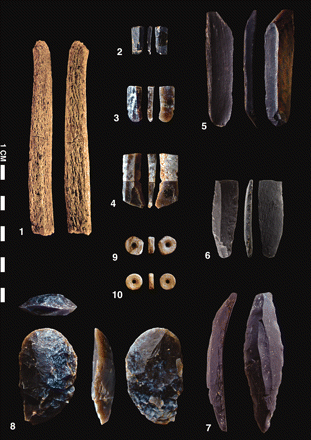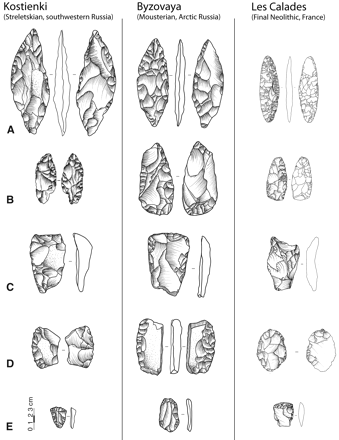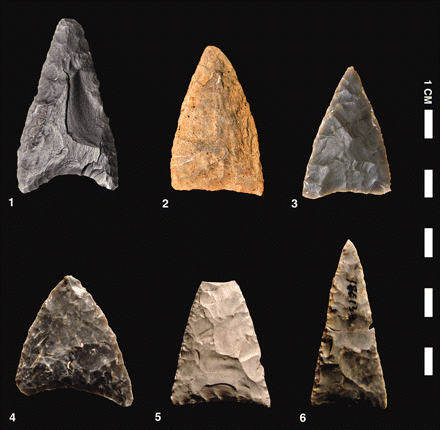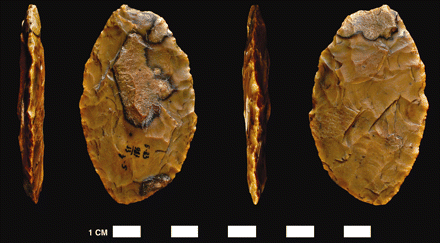L. Slimak / J. I. Svendsen / J. Mangerud / H. Plisson / H. P. Heggen / A. Brugère / P. Y. Pavlov
Source - http://www.sciencemag.org/content/335/6065/167.3.full
Contrary to what Zwyns et al. claim on a bibliographical basis, the lithic industry of Byzovaya cannot belong to the Streletskayan complex or be considered as Upper Palaeolithic (UP). Direct analysis of northern assemblages and of Streletskayan technologies reveals incompatible features between these industries. Byzovaya is structured on specific Mousterian technologies and does not show any unique features of the UP.
The main criticism by Zwyns et al. (1) is that they think that the Byzovaya assemblage “fits within the variability displayed by Early Upper Paleolithic....Streletskaya technocomplex.” They support their view by making a comparison with some selected artifacts from the UP sites of Zaozer’e, Garchi, and Kostenki farther to the south. We previously performed an in-depth analysis of all these industries and disagree with their assertion that the Byzovaya material offers several points of resemblance with these and other UP sites. Our direct analyses reach the conclusion that three distinct Palaeolithic Boreal traditions existed over a period covering at least 7 millennia (2). In all, 2437 lithic elements were available from the Zaozer’e site, including our 2008 field campaign. This includes 107 tools, as compared with 80 from Byzovaya. Zwyns et al. claim that in Zaozer’e “there is also a strong Middle Paleolithic component dominated by small plano-convex bifacial tools, similar to those found in the eastern European Mousterian but, importantly, also similar to the reported Keilmesser of Byzovaya.” Zaozer’e is dominated by retouched blades, representing 28 of the 107 tools. We found 14 plano-convex elements that represent an original category: bifacial end-scrapers presenting a regular circular front, for which no Mousterian equivalence is known (Fig. 1). Zwyns et al. further assume that “low frequency of small stone artifacts” at Byzovaya would explain the “absence of UP elements such as small blades, pendants, or antler points that sometimes occur within similar assemblages in primary context.” This is not substantiated by the facts, as small elements (<2 cm) are even more frequent from Byzovaya (20.8%) than from Zaozer’e (16.3%). The Zaozer’e collection also presents a variety of large tools and subproducts on bone, antler, and ivory, which is typically UP (Fig. 1).

Fig. 1 Zaozer’e industry is, like any other UP industry, based on blade and bladelets technology. The plano-convex tools are 14 very specific end-scrapers. Moreover, the industry contains various evidence of bone, ivory, and antler technology, including ornaments. None of these elements is present in Byzovaya, and their combination is unknown in the Mousterian industries of Eurasia. (1) Antler tool. (2 to 4) Bladelets. (5 to 7) Blades. (8) Zaozer’e end-scraper shaped from plano-convex blank. (9 and10) Fossil pendants. [Photos by L. Slimak]
As many as 5000 lithic elements have been uncovered from Garchi. This includes many characteristic triangular points with a concave base that is considered diagnostic of the Streletskayan industry. The remaining artifacts are for the most part subproducts of this point production. Finally, a few small end-scrapers that are shaped directly from siliceous pebbles are present, and none of the lithic elements at Garchi share any technological similarities with the artifacts from either Byzovaya or Zaozer’e. Direct technological data show that Byzovaya, Zaozer’e, and Garchi represent three different technical traditions that are not related to each other. The Garchi lithics are typical of UP Streletskayan industries, and it seems clear that Zaozer’e also belongs to a UP complex. These sites present incompatible technologies, corroborating our previous conclusion that they present no technical relation with Byzovaya. Zwyns et al. discuss the Levallois technology of Byzovaya. They argue that the core shown in our figure 3 (3) would lack a clear preparation of the flaking surface that would be typical for this technology. We lean on the explanation provided by Bordes (4): “the expression ‘facetted butt,’ taken in the sense of the Levallois technique, is absolutely erroneous, because there are many flakes with facetted butts that are non-Levallois, and there exist Levallois flakes with a flat butt” (5). Their position is hardly understandable because they refer to a major publication giving the Levallois diagnostic features that absolutely fit with the Byzovaya elements (6).The less-disputed way to demonstrate a Levallois technology is based on the core geometry and structure that demonstrate that at Byzovaya, Levallois technologies illustrate the preferential method, the most diagnostic feature of the Mousterian. Zwyns et al. assume that “Comparison between Streletskayan assemblages from Kostenki 1 level V (A), Kostenki 12 level III (B to E), and Byzovaya” would demonstrate that tools described as typically Mousterian by us occur in Streletskayan complexes. However, they do not compare the full “assemblages” but illustrate their view from drawings of five selected objects from Byzovaya and five others from two different sites of Kostenki. In our opinion, this approach is misleading because it: (i) is based on second-hand data, (ii) focuses on a handful of selected objects, (iii) mixes elements from different sites, and (iv) isolates objects from their specific technological context. Any lithic element belongs to a coherent system that has to be examined as an entity. In this case, their supposed similarities are very vague. For making this clear, we added five tools from a French final Neolithic site to figure 2 in (1) (Fig. 3), illustrating the danger of such analogic methods.
 Fig. 3 Tools from Les Calades shown alongside the drawings from figure 2 in (1). The comparison of morphological traits out of their specific technological and archaeological context is misleading. Designations from (1) are misleading because they are extracted from their specific archeological context and their precise technological background: “(A) Leaf point. (B) Bifacial knife (with scalar retouch). (C) Mousterian scrapers. (D) Quina-type side-scrapers. (E) End-scrapers.” [Drawings from Les Calades sites by R. Furestier]
Fig. 3 Tools from Les Calades shown alongside the drawings from figure 2 in (1). The comparison of morphological traits out of their specific technological and archaeological context is misleading. Designations from (1) are misleading because they are extracted from their specific archeological context and their precise technological background: “(A) Leaf point. (B) Bifacial knife (with scalar retouch). (C) Mousterian scrapers. (D) Quina-type side-scrapers. (E) End-scrapers.” [Drawings from Les Calades sites by R. Furestier]
Before our original paper was published, we performed a first-hand technological comparison with Streletskayan assemblages from the well-known UP sites Kostenki 6 (the eponymous Streletskayan) and Biryuchya Balka, which offers the richest collection of such an industry. We could not find a single element reflecting a real Mousterian technology. We suspect that the so-called archaic structure is the frequent occurrence of retouched flakes whose blanks occur from the bifacial shaping of the concave-base points as at Garchi (Fig. 2). However, it is noteworthy that none of the 50,000 artifacts from Biryuchya Balka could be confused with a Levallois or discoid artifact by any experienced lithicist.

Fig. 2 Small concave base-point production represents the main diagnostic feature of the Streletskayan industries. It is based on precise technological criteria easily recognizable both in the structure of these projectiles points and in the numerous subsequent subproducts. (1 to 3) Garchi. (4 to 6) Biryuchya Balka. [Photos by H. Plisson and L. Slimak]
Zwyns et al. interpret the elements from Kostenki and Byzovaya shown in figure 2A in as a “leaf point” (Blattspitzen). The artifact from Kostenki is more than 2 cm thick and has very irregular edges and two differently shaped faces—one with flat covering retouch, the other scalar, showing that it represents an unfinished and undiagnostic bifacial element. We are much in doubt about this classification. In contrast, their selected artifact from Byzovaya is much thinner and more regular but bears a plano-convex construction. To be precise, such tool is no more compatible with the leaf-point definition but appears classically among Mousterian technologies. Figure 4 shows a Blattspitzen from Byzovaya, symmetric across all axes, with indisputable regular edges. Flat retouch covers each face, and the tool is only few millimeters thick. We consider it a classic example of its category, typical for the Central and Eastern European Mousterian industries and distinctively different from the unconvincing example from Kostenki.
 Fig. 4 Byzovaya. Real Blattspitzen. [Photos by Ludovic Slimak]
Fig. 4 Byzovaya. Real Blattspitzen. [Photos by Ludovic Slimak]
The given samples of “Quina-type side-scrapers” [figure 2D in are no more relevant; the one from Byzovaya is an artifact struck from a natural slate and shaped by a bifacial flat retouch.
Finally, the commenters argue for the lack of Middle Palaeolithic sites previously found in the region. We underline that, since the 19th century, Palaeolithic research has been conducted there by only three archaeologists, in an area bigger than France and where Pleistocene discoveries are restricted to eroded river banks. We therefore warn against conclusions based on negative evidence. Such debate cannot stay at such a binary level and within a closed frame that would exclude any new data. First-hand analyses reveal the existence of at least three distinct traditions, illustrating concretely the complexity of the High Latitudes colonization. Byzovaya is typically Mousterian according to its original definition, which does not depend on the biological identity of the knapper or on other aspects of hominin social organization. In Europe, Mousterian industries have so far always been associated with Neandertals, a reality that could be dismissed, but only by concrete facts. From current knowledge, the Byzovaya technologies probably reveal a Neandertal Arctic persistence, although we still stick to our statement from our original paper; “whether Byzovaya represents a Neandertal site or not cannot be demonstrated beyond doubt until human bones or DNA are found”.